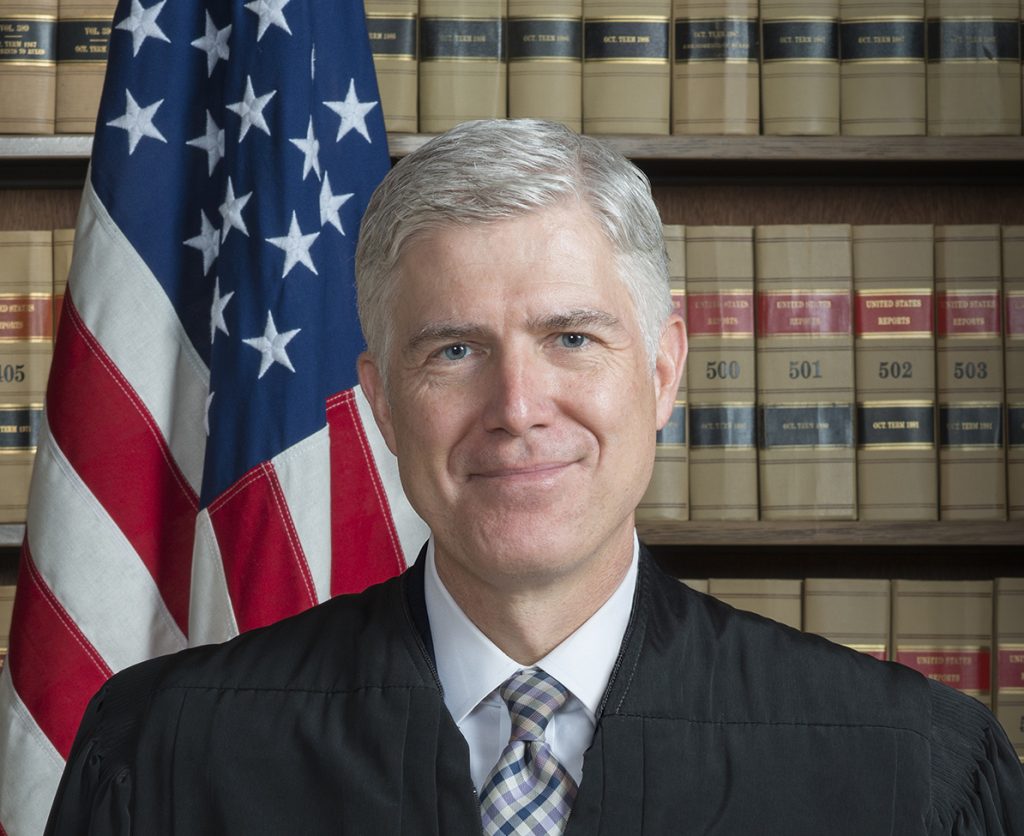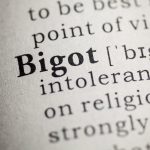The Supreme Court ruled on June 4 in favor of Jack Phillips, the evangelical baker who could not in good conscience create a custom cake celebrating a same-sex couple’s wedding. The Court found that the officials who ordered Phillips to serve gay weddings were operating with an anti-religious bias. It thus based its decision on the free exercise clause, saving for another day the baker’s main argument, rooted in his right to freedom of expression.
Debate over the case has focused on how much protection this free exercise holding will provide for other creative professionals. In fact, that debate began with the justices themselves. Four who joined Justice Kennedy’s majority opinion also joined concurrences that dueled over how broadly to read their shared majority opinion. Curiously, though, each of these concurrences seems to beg the question against the other. And no clear resolution of their dispute has emerged in the ensuing public debate. That is because everyone—justices, scholars, and commentators on both the left and right—assumes we can determine the scope of the Court’s free exercise ruling without touching on Phillips’s free speech claim.
That’s a mistake. A closer look shows, surprisingly, that we can’t assess the implications of the free exercise argument relied on by the Masterpiece majority without taking a position on a key premise of the free speech argument the majority left untouched. The majority’s refusal to address any part of the free speech issue explains the intractability of the present debate over the reach of its free exercise ruling. Three conservative justices—Gorsuch, Alito, and Thomas—would resolve the speech-related issue in a way that would turn out quite helpful to believers like Phillips. Justice Kagan, joined by Justice Breyer, goes the other way. The conservatives have the better of the argument—as confirmed, stunningly, by an explicit concession in the dissent by Justice Ginsburg, joined by Justice Sotomayor.
Before getting to that, I’ll highlight three aspects of the Court’s decision that will help religious claimants, no matter how the main legal issues are resolved. Then I’ll look at the two concurrences that dispute the meaning of the majority’s ruling, and show that we can’t settle the issue without deciding on a component of the very free speech argument the majority had hoped to sidestep.
Start your day with Public Discourse
Sign up and get our daily essays sent straight to your inbox.Three Positive Aspects of the Decision
First, a brief recap of the case: In 2012, the Colorado Commission on Civil Rights found that Jack Phillips had violated state bans on discrimination based on sexual orientation when he refused to design and create a custom wedding cake celebrating a same-sex wedding. The Commission ordered Phillips to create cakes for same- as well as opposite-sex weddings or else quit the wedding-cake business altogether. Phillips countered that the Commission had (1) violated his freedom of speech and expression (in particular, his right against “compelled speech”) by forcing him to create artistic expression carrying a message he rejects, and (2) violated his free exercise rights by coercing him but not secular bakers in other cases who had refused a Christian customer’s request for cakes carrying religious messages hostile to same-sex relations.
Accepting Phillips’s free speech argument would have delivered a robust victory to creative professionals, but in an appropriately limited range of cases. It would have established a right not to be forced to create forms of artistic expression whose context imposes on them a message their creator rejects. Such a ruling would protect wedding photographers, for example, but not those catering the salad or renting out folding chairs for the reception. As I have argued at Public Discourse, this free speech argument is stronger than most commentators recognize; indeed, it’s conclusive. Justice Thomas defends it in his concurrence, providing a roadmap for future litigators and powerful authority for them to cite. His opinion will lead many open-minded scholars and practitioners to take the argument seriously for the first time. The majority makes nods in the direction of this argument (and nods in the opposite direction, and nods in no particular direction). But it ultimately takes no position on the free speech claim, which lives to fight another day.
But even without that decisive victory on free speech—and the more tenuous free-exercise victory discussed below—claimants like Phillips will benefit from three features of this case.
First, seven justices here join opinions firmly rejecting the idea that states can outlaw action based on a given belief merely because they judge that belief offensive—even when the belief at stake is the much-reviled conjugal view of marriage, and even when the related action falls under bans on discrimination in public accommodations. This is an overlooked point of enormous importance. For years, increasing numbers of litigants and scholars have argued that First Amendment claims might be overridden by a state interest in fighting dignitary harm—the harm of being told that actions central to your self-understanding are immoral. Accepting this troubling argument would gut the First Amendment. Here the Court rightly rejects it.
Second, seven justices here join opinions either saying or implying that traditionalism on marriage isn’t the new Jim Crow. If Phillips deserved to be treated like a racist, after all, the majority would not have balked at Colorado officials’ dismissiveness toward his religion. (There’s nothing wrong with being dismissive of racism.) This solicitude for Phillips, this acknowledgment of the decency and respectability of his views, is no small thing. It contradicts the rhetoric of the loudest progressive voices in this culture war, in ways that will exert a soft power over future litigation.
Finally, two justices of the Supreme Court—Gorsuch and Alito—have now elevated a crucial point often missed by friends and foes alike of Jack Phillips (one that Ryan Anderson and I discuss on pages 248-50 in our book Debating Religious Liberty and Discrimination): namely, that if Phillips’s action is discrimination based on orientation (because of the link between same-sex desires and same-sex marriage), then progressive opposition to traditionalism on marriage must be discrimination based on religion. Conversely, if you can punish the Jack Phillipses of the world without discriminating against Christians as such, you can decline to serve gay weddings without discriminating against gay people as such. (As Anderson put it in the Georgetown Journal of Law and Public Policy, Disagreement Is Not Always Discrimination.) Or, in the words of Justice Gorsuch’s concurrence:
If Mr. Phillips’s objection is “inextricably tied” to a protected class, then the bakers’ objection in [conservative Christian patron] Jack’s case must be “inextricably tied” to one as well. For just as cakes celebrating same-sex weddings are (usually) requested by persons of a particular sexual orientation, so too are cakes expressing religious opposition to same-sex weddings (usually) requested by persons of particular religious faiths. In both cases the bakers’ objection would (usually) result in turning down customers who bear a protected characteristic.
In a moment, we’ll see that this point is essential to judging the implications of Masterpiece, which bars officials from imposing double standards when enforcing bans on religious and sexual-orientation discrimination.
The Implications of the Court’s Free Exercise Ruling
To return to the main thread: What does the Court’s free exercise ruling mean for other cases? Those who say “not much” would argue as follows:
Justice Kennedy found that Commission’s order violated the Free Exercise Clause—and thus had to be set aside—because it was rooted in hostility toward religion. And the Court’s evidence for this hostility consisted of a few comments by commissioners who disparaged religion during the proceedings against Phillips by blaming believers for atrocities like slavery. So long as officials in other cases don’t slip and say mean things about religion, then Masterpiece won’t cut against them.
This is wrong twice over. First, it’s optimistic to think that other claimants will find no hostile official comments to cite in court. It’s standard for progressive culture warriors to compare believers like Phillips to perpetrators of the worst injustices. So I expect records of official proceedings to provide plenty of fodder for future litigants. And herein lies a great irony. Progressive judicial victories have often relied on unfair inferences of animus in the hearts of citizens and lawmakers, and on contested readings of messy legislative histories. Now these judicial tools have cut against progressives’ policy goals.
Second, the narrow reading of Masterpiece assumes that the majority in Masterpiece rests its whole decision on hostile comments by commissioners. But that’s only part of the Court’s reasoning. The rest points to double standards the Commission applied to religious vs. secular claims:
– When secular bakers refused a religious customer’s request for cakes conveying opposition to same-sex relations, the Commission found the bakers innocent because their refusal was based on the customer’s requested message, not his protected status. But it rejected a similar defense by Phillips.
– The Commission relied on the fact that the secular bakers would sell the religious customer any other product. But it rejected Phillips’s defense that he would do the same for gay couples.
– The Commission dismissed Phillips’s concerns on the ground that observers would attribute the cake’s message to his customers, not to him. But it said nothing of the sort in the secular bakers’ cases.
In short, Masterpiece establishes that state agencies may not apply anti-religious double standards. So, to determine this ruling’s implications, we have to ask: Will state agencies seeking to coerce other religious claimants be willing to avoid all double standards? The answer will obviously turn on what counts as a double standard. This is where all the action is. This is what will determine whether Masterpiece is remembered or forgotten five years from now. This is what Justices Kagan (joined by Breyer) and Gorsuch (joined by Alito) dispute in their two rival concurrences, under the guise of merely clarifying the majority opinion they’ve all joined.
The Kagan-Gorsuch Debate
Both concurrences grant the following principle: To avoid violating bans on discrimination based on orientation (or religion), you have to be willing to make the same product for people of one orientation (or religion) that you would for people of another. You can choose what to make, but not whom to make it for.
The concurrences simply disagree on what counts as the “same product.” Or more precisely, they fight over whether there was a single coherent reading of “same product” that could have allowed the Commission to rule against Phillips but in favor of the secular bakers. Justice Kagan says there was; Justice Gorsuch disagrees. (A slip in Justice Ginsburg’s dissent actually supports Gorsuch’s view. More on that in a moment.)
Kagan’s reply to Gorsuch comes in a footnote:
In [Justice Gorsuch’s] view, the Jack cases [involving secular bakers’ refusals to bake cakes bearing anti-gay-marriage messages] and the Phillips case must be treated the same because the bakers in all those cases “would not sell the requested cakes to anyone.” . . . Justice Gorsuch can make [this] claim [about Phillips’s case] only because he does not think a “wedding cake” is the relevant product [in Phillips’s case]. As Justice Gorsuch sees it, the product that Phillips refused to sell here—and would refuse to sell to anyone—was a “cake celebrating same-sex marriage.” . . . But that is wrong. The cake requested was not a special “cake celebrating same-sex marriage.” It was simply a wedding cake—one that (like other standard wedding cakes) is suitable for use at same-sex and opposite-sex weddings alike . . . And contrary to Justice Gorsuch’s view, a wedding cake does not become something different whenever a vendor like Phillips invests its sale to particular customers with “religious significance.” As this Court has long held, and reaffirms today, a vendor cannot escape a public accommodations law because his religion disapproves selling a product to a group of customers, whether defined by sexual orientation, race, sex, or other protected trait. A vendor can choose the products he sells, but not the customers he serves—no matter the reason. Phillips sells wedding cakes. As to that product, he unlawfully discriminates: He sells it to opposite-sex but not to same-sex couples.
Here Justice Kagan—a deadly brilliant jurist and an equally brilliant writer—seems to beg the question. The passages I’ve highlighted state her position against Gorsuch but hardly defend it. The two sentences falling between those passages simply restate the principle she shares with Gorsuch, and whose significance is precisely what they dispute.
But neither is Gorsuch’s reply fully satisfying: “Words or not and whatever the exact design, [a wedding cake] celebrates a wedding, and if the wedding cake is made for a same-sex couple it celebrates a same-sex wedding.” But what authority supports this claim over Kagan’s alternative? What justifies a judge’s reliance on it? I think the best answer is that it flows from a principle the Court established in an earlier decision, which held that “[t]he context in which a symbol is used for purposes of expression is important, for the context may give meaning to the symbol.”
Now here’s the key: that earlier decision is about free speech, not free exercise. So is the dispute between Kagan and Gorsuch. They’re debating whether and how an expressive item’s purpose and context determine the message it carries. That’s what free speech law tells us. That’s what Phillips addresses in his free speech argument. It’s what Justice Thomas discusses in his concurrence on the free speech issue, writing that “a wedding cake needs no particular design or written words to communicate the basic message that a wedding is occurring, a marriage has begun, and the couple should be celebrated.” But while Thomas’s concurrence is explicit about addressing Phillips’s free speech argument, Kagan’s and Gorsuch’s concurrences address a key premise of that speech argument only implicitly—but inevitably—in trying to settle the reach of Phillips’s free exercise win.
Gorsuch might deny that touching on free speech questions is inevitable. He says that if Phillips objects to baking even wordless cakes for same-sex weddings, it would violate Phillips’s religious liberty (quite apart from free speech) for courts to suggest that he “must be forced to write words [on the cake…] before his religious faith is implicated.” But courts needn’t say that in order to judge whether the Commission applied a double standard against Phillips, which is the issue here. They needn’t determine whether baking a wordless cake violates Phillips’s faith, but only whether it forces him to create something that is just as expressive as a cake with anti-gay words would be. That’s not a theological question, but one of free speech.
Ginsburg, Context and Meaning
And on that question, again, Justices Gorsuch, Alito, and Thomas are right: since context shapes a symbol’s meaning, a wedding cake celebrates the wedding it’s made for. The stunning thing is that Justice Ginsburg (joined by Sotomayor) says exactly that in her dissent, with italics to boot: “When a couple contacts a bakery for a wedding cake, the product they are seeking is a cake celebrating their wedding—not a cake celebrating heterosexual weddings or same-sex weddings.” Set aside Ginsburg’s apparent suggestion that Phillips might object to celebrating same-sex marriage in the abstract, but not to celebrating actual same-sex marriages. The point is that two progressive justices provide explicit support for three conservative justices’ view that a cake custom-made for a wedding carries a celebratory message about that couple’s bond.
Also supporting this view are cases in which the Court has read quite specific messages into symbolic items based on much fuzzier contexts than that provided here by a wedding reception. In one case, the Court found that the display of an upside-down flag with an attached peace sign carried an anti-war message because of its timing. Draped at a time of escalating international conflict, it conveyed opposition to military action in Cambodia. Now if the current events that overlap in time with an expressive item can specify its meaning, so can the once-in-a-lifetime party for which an expressive item is explicitly and exclusively designed—especially when that party’s sole and unmistakable purpose is to celebrate a proposition: “This couple just got married!”
Contrary to Justice Kagan, then, two cakes that look the same will have different meanings if they celebrate different events. Indeed, it is incoherent to grant that the words on the cake matter while denying that the context for which it’s made also matters. After all, the only reason to care about forcing a baker to inscribe certain letters is that this might force him to inscribe something with a meaning he rejects. Yet meaning isn’t just about letters; it necessarily depends on context. So if you care about letting the baker choose which letters to write, you have to let him choose his context. In an earlier Public Discourse essay I offered counterexamples to Kagan’s view that should appeal to progressives. But Alito illustrated the same point at oral argument:
So if someone came in and said: I want a cake for—to celebrate our wedding anniversary, and I want it to say “November 9, the best day in history,” okay, sells them a cake. Somebody else comes in, wants exactly the same words on the cake, he says: “Oh, is this your anniversary?” He says: “No, we’re going to have a party to celebrate Kristallnacht.” He would have to do that?
That an expressive item’s context shapes its meaning is essential to judging Phillips’s speech argument, and also essential for telling whether the Commission applied a double standard—which in turn determines what Masterpiece will means for other cases. Cakes made to order for same-sex weddings bear a pro-same-sex marriage message, just as cakes with anti-gay words carry an anti-gay message. So, to avoid double standards, any state seeking to coerce believers like Phillips must also stand ready to coerce secular bakers to take, say, a Muslim’s order for cakes bearing anti-gay-marriage words and symbols. (Ditto, mutatis mutandis, for others creating forms of artistic expression for contexts that give their products an unwelcome message.) Since most states won’t be willing to do that, most will be effectively barred by Masterpiece from coercing people like Phillips—if courts credit the free speech-related premise latent in Gorsuch’s concurrence, endorsed in Thomas’s, defended here and above, and drawn from the Court’s free speech cases.
In short, to clarify its free exercise ruling, the Court must face the free speech argument that Masterpiece assiduously tries to avoid.













